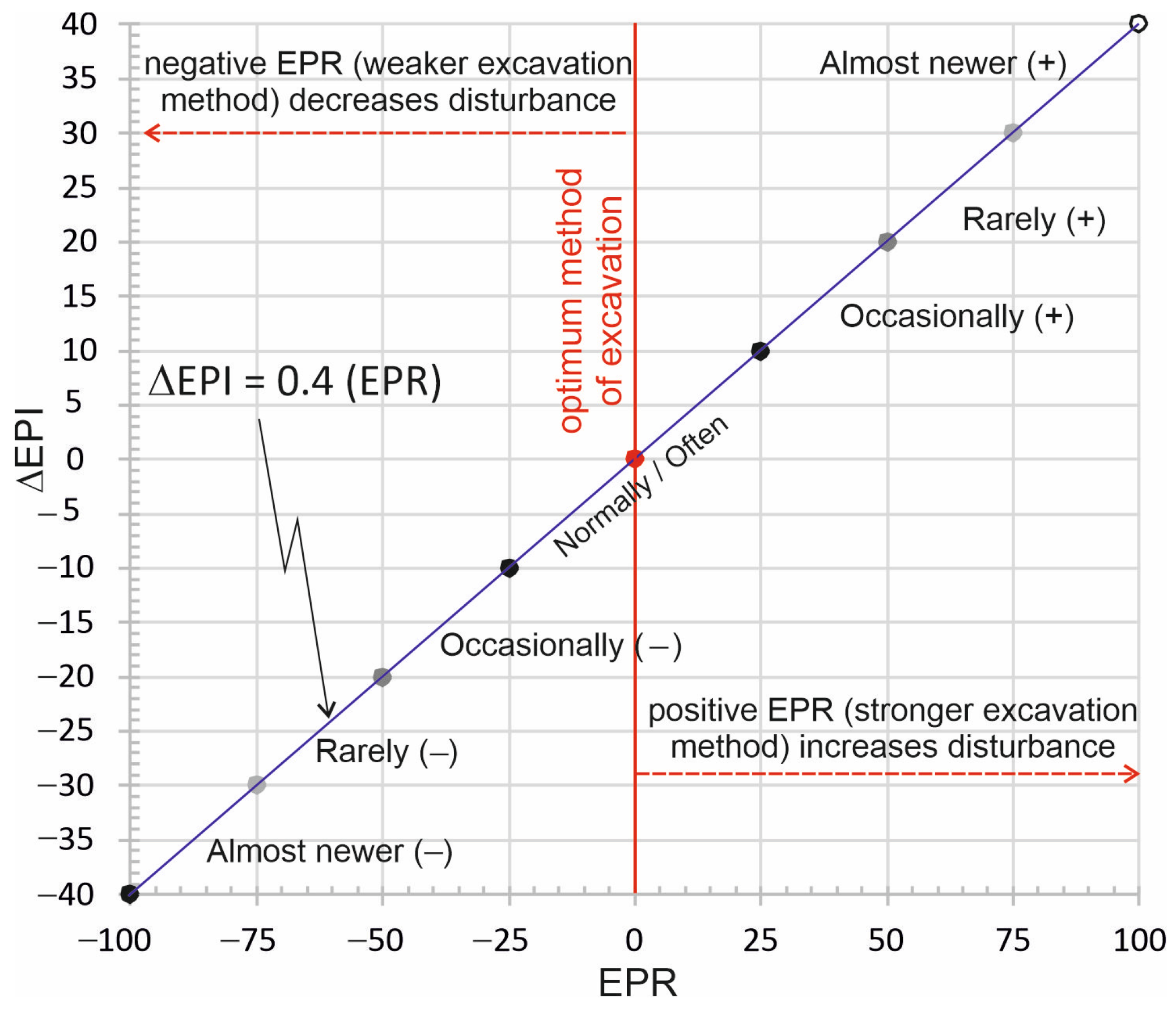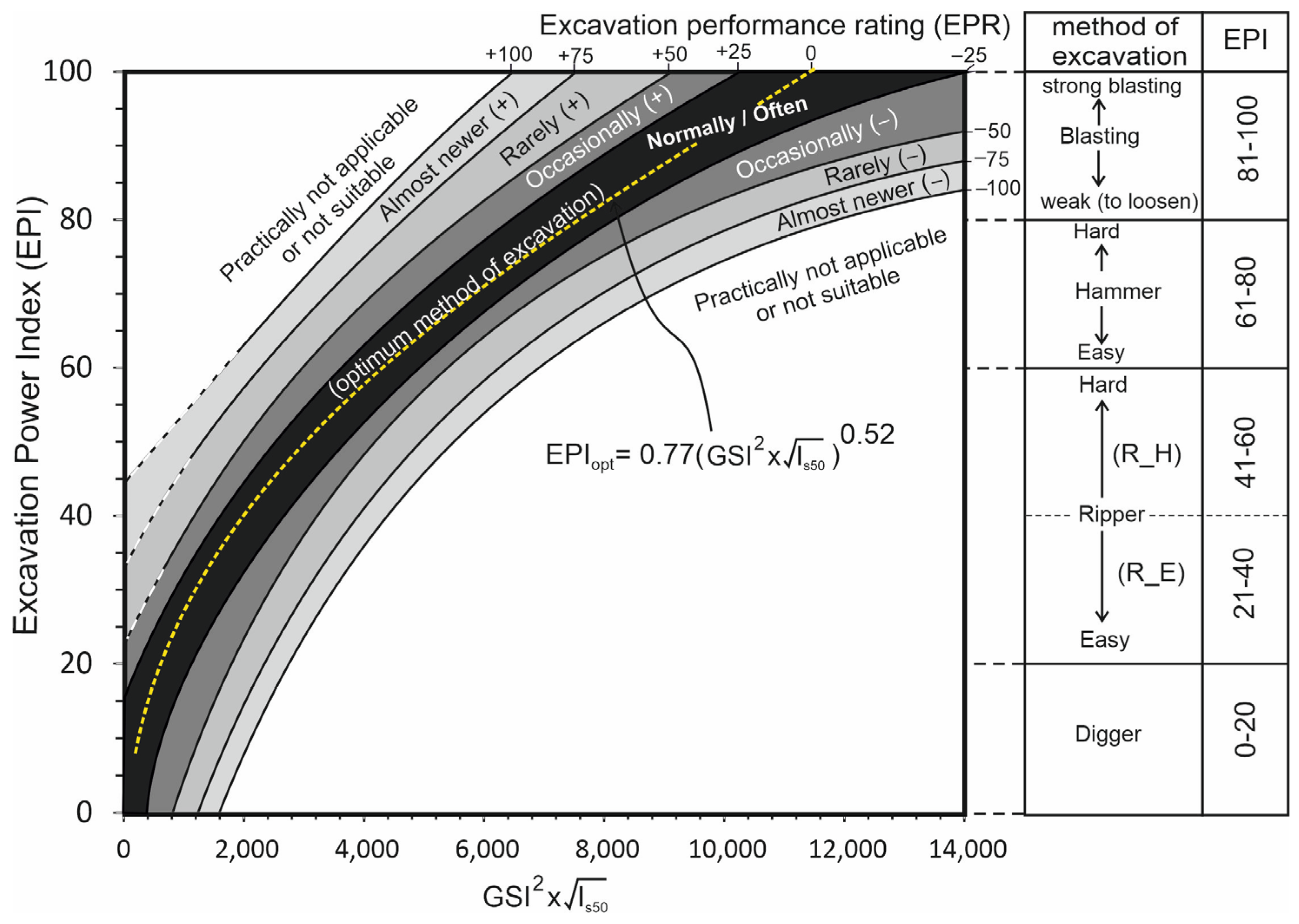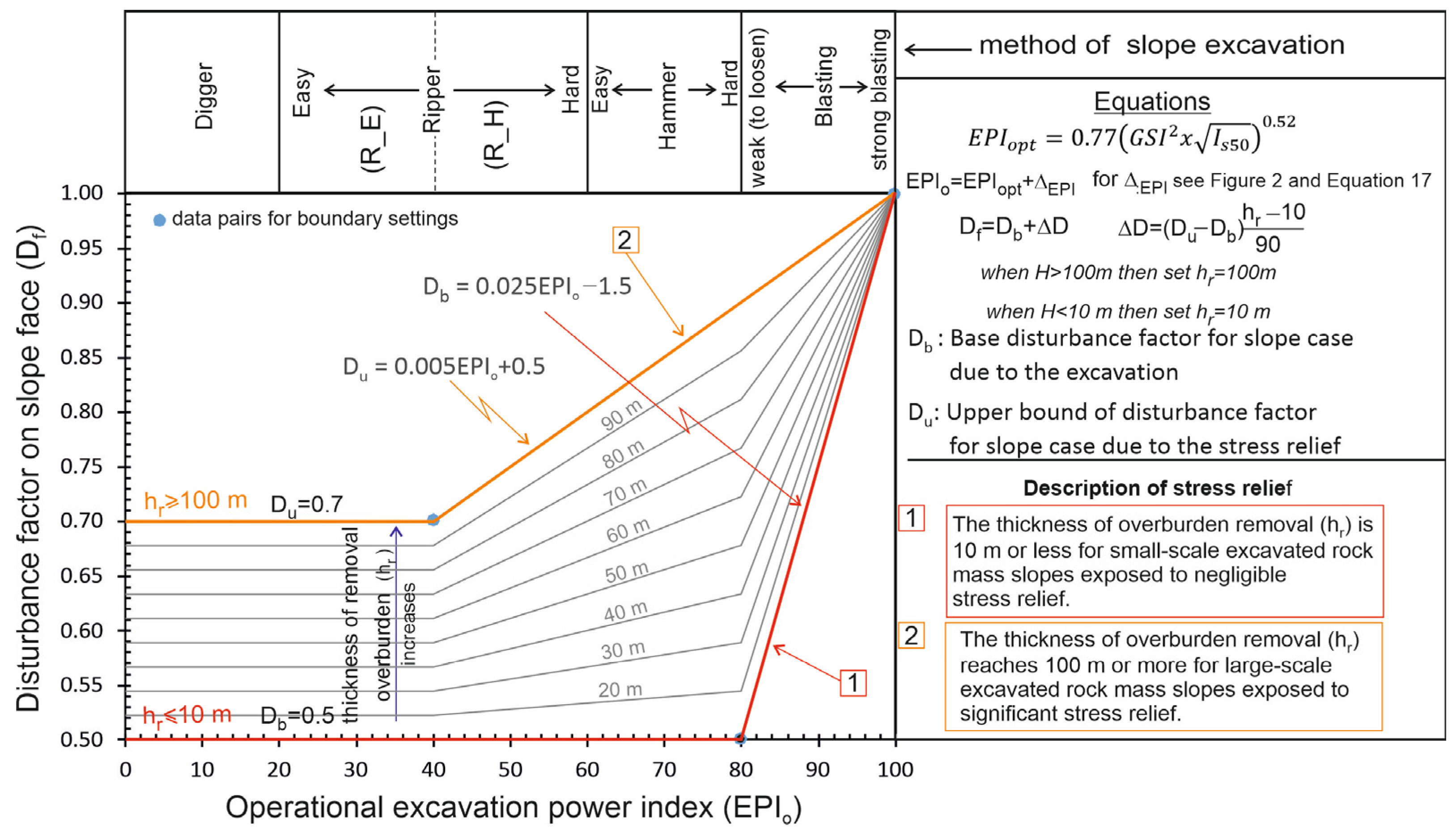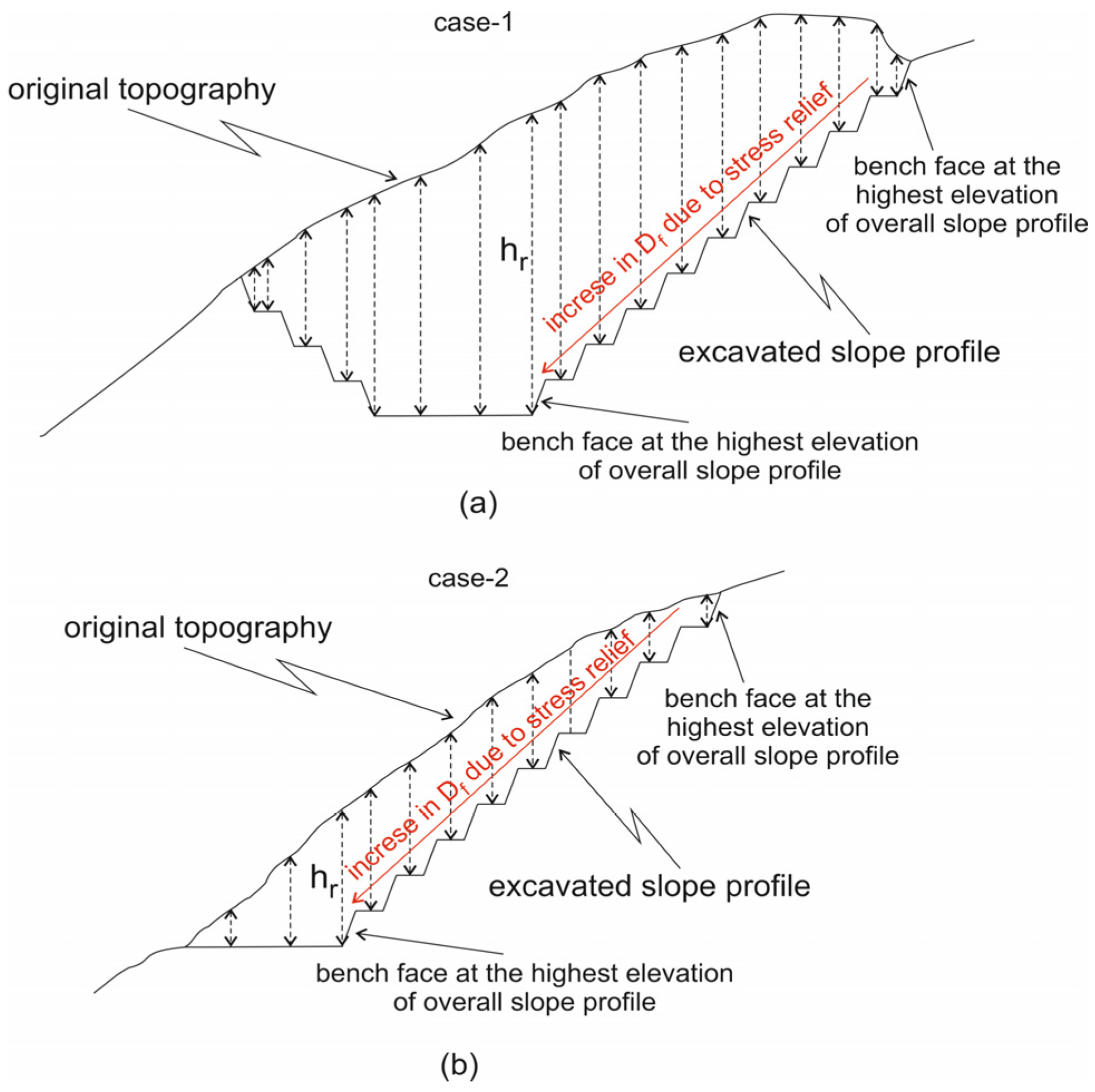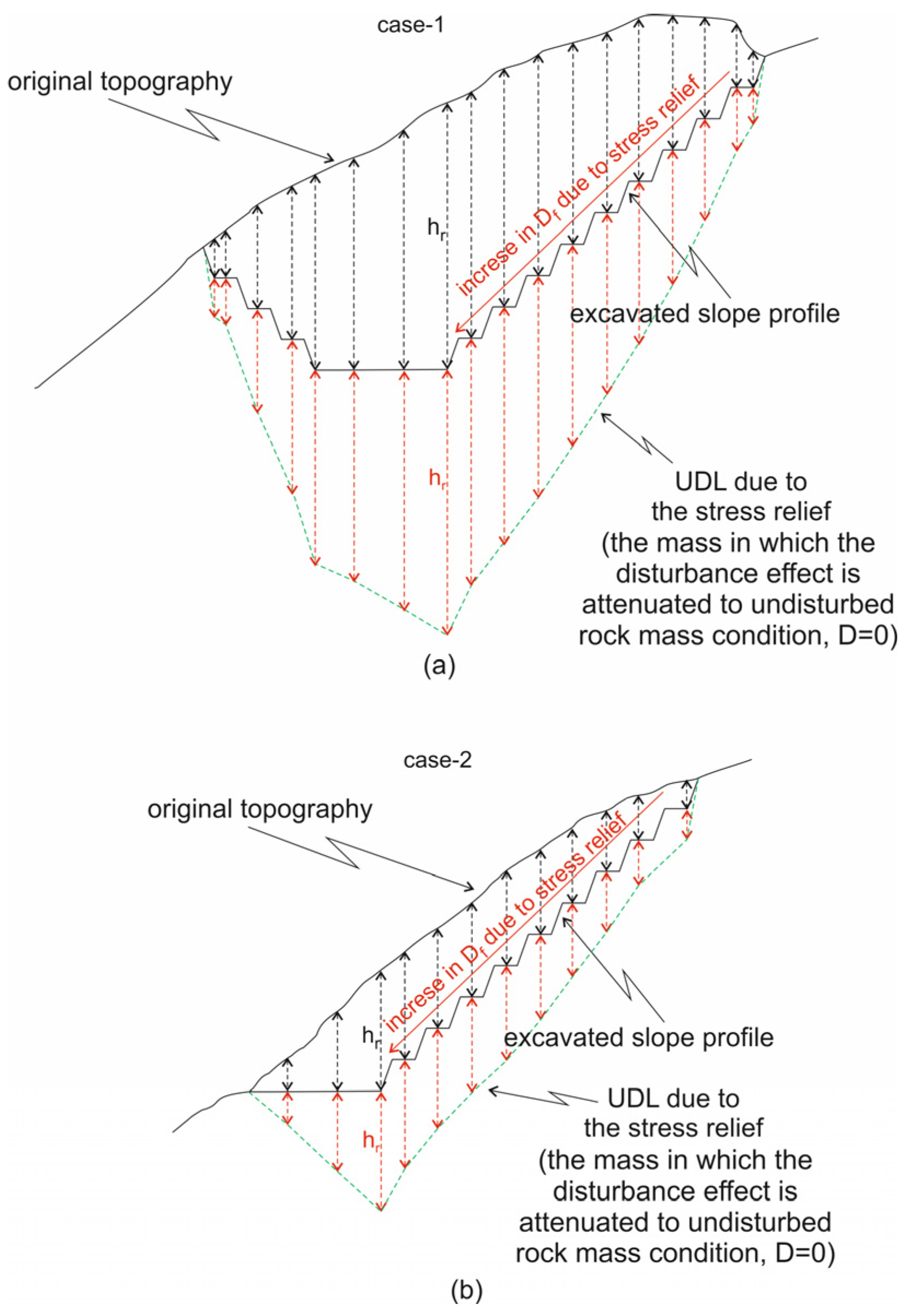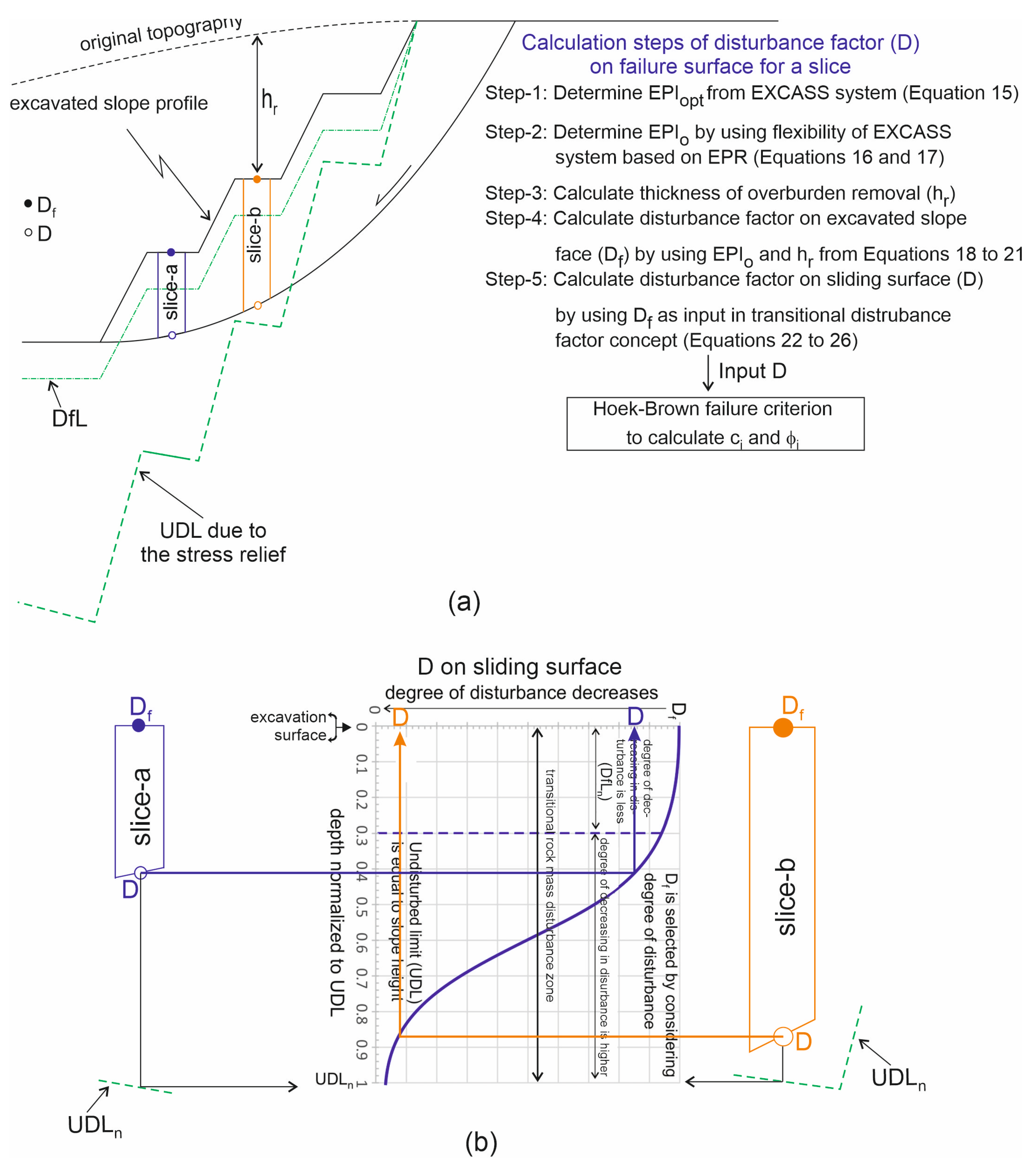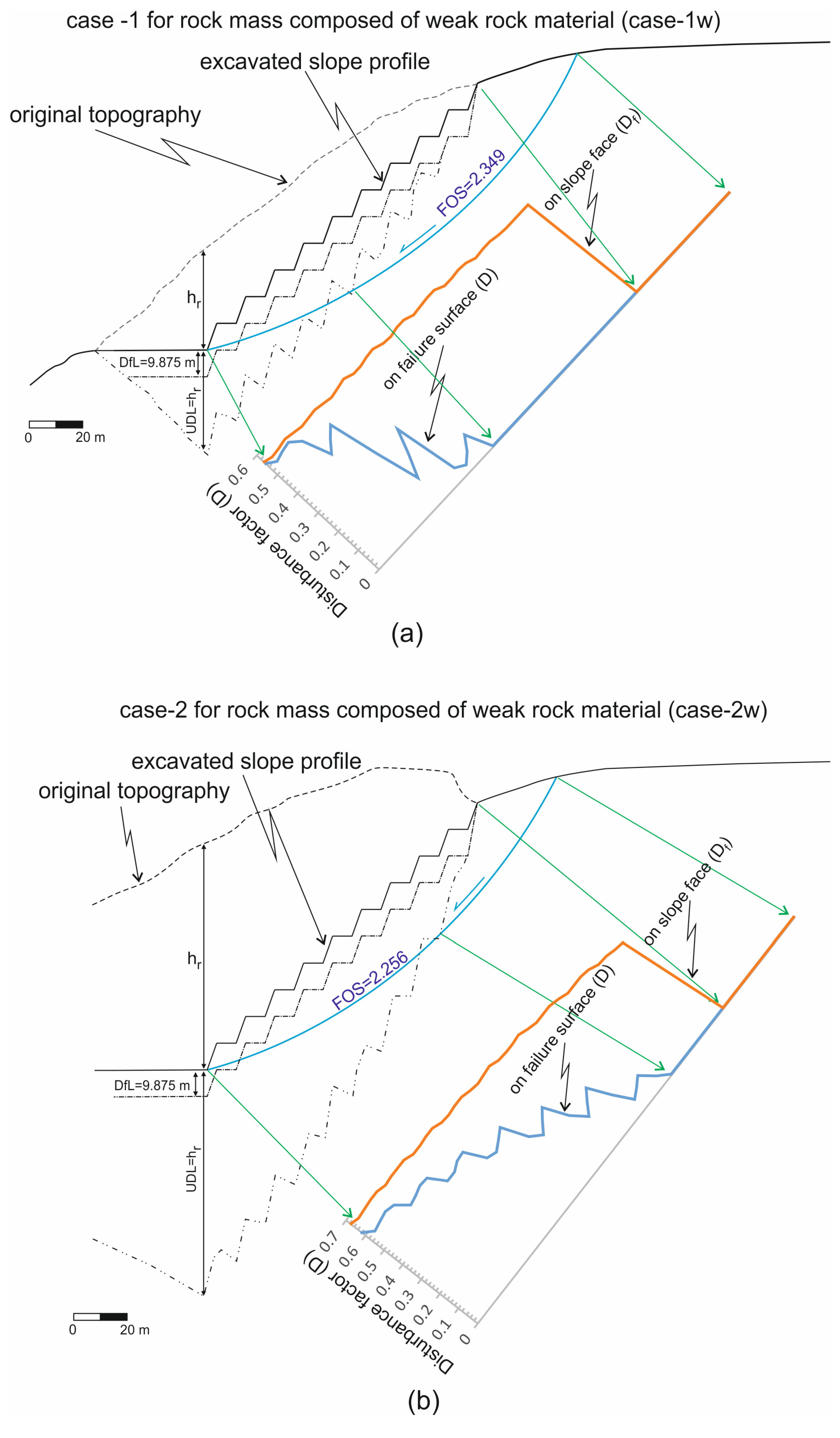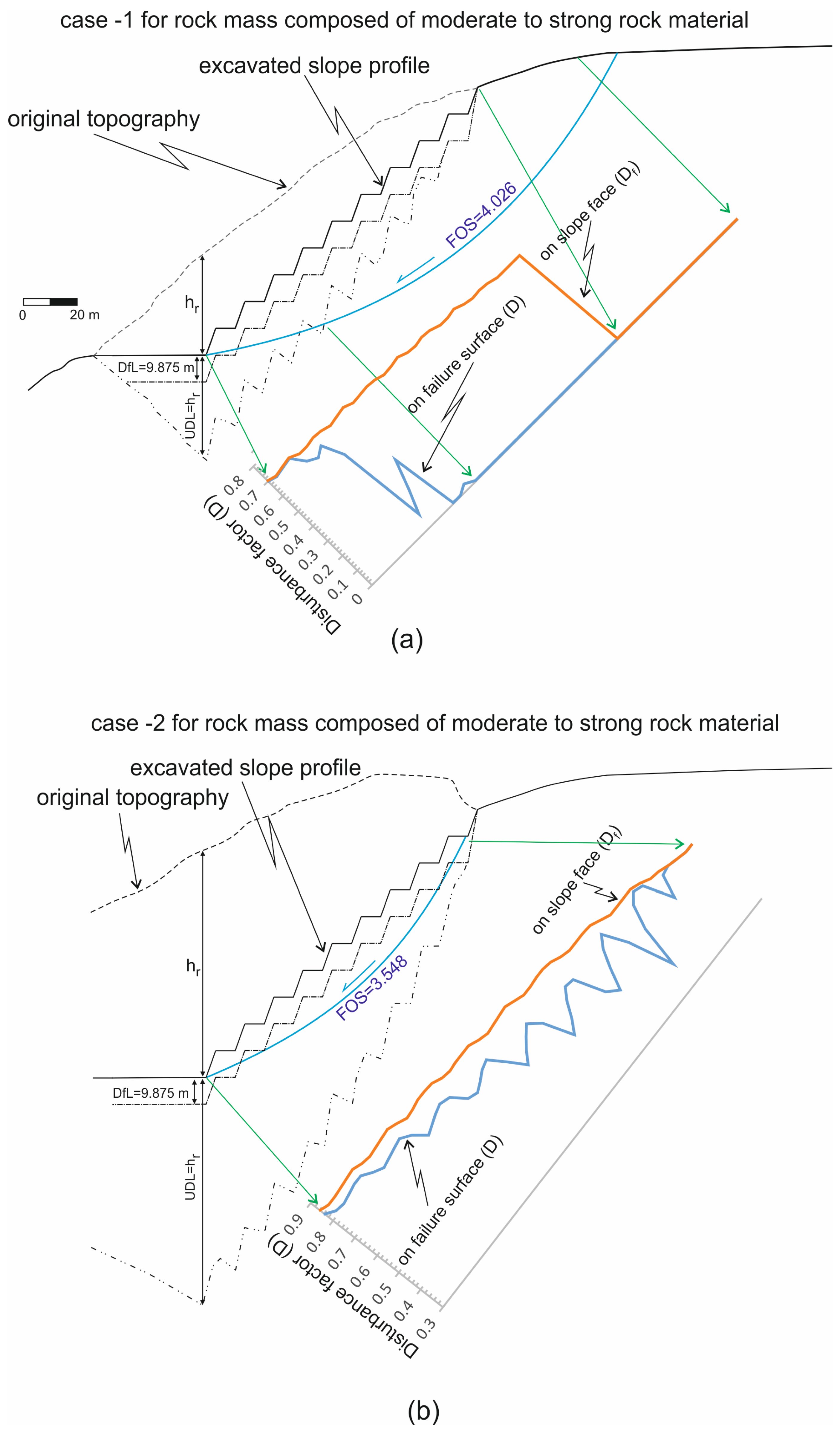2.1. Key Studies on Rock Mass Disturbance
A simple definition of a rock mass is an engineering volume composed of rock material and the discontinuity planes that bound it. In engineering applications such as dams, tunnels, and slopes, it is inevitable that the virgin stress state of the rock mass will change. Excavation of rock masses is required in many rock mechanics applications, such as dam construction, mining activities, and highway construction. For such technical initiatives, from an engineering perspective, excavation costs should be minimized as much as possible by using optimum excavation methods (e.g., blasting, digging, ripping, drilling) based on the mechanical properties of the rock masses. Depending on the excavation method applied in slope excavations, new cracks develop, with their abundance decreasing from the excavation surface to the depth. As discussed by Hoek and Brown [
6], another disturbance effect that increases in significance with increasing slope excavation depth is the removal of the rock mass, resulting in stress relief. This causes the surrounding rock mass to relax and dilate.
The guidelines for estimating the disturbance factor (
D) proposed by Hoek et al. [
3] were revised by Hoek and Brown [
6], considering both stress relaxation and blasting damage. However, the updated guideline, which includes stress relaxation and blasting damage, provides descriptions of rock masses that define only two classes based on the scale of slopes. The first description, based on the disturbance viewpoint, refers to relatively small-sized slopes typically encountered in civil engineering applications. For this category of relatively small slopes,
D = 0.5 is recommended for controlled presplit or smooth-wall blasting with moderate rock mass damage.
The second description, based on the disturbance viewpoint, pertains to relatively large open-pit mine slopes. According to the rock mass disturbance description for large-scale slopes provided by Hoek and Brown [
6], stress reduction damage primarily due to stress relief occurs, even when mechanical excavation methods are applied to excavate slopes in some weak rock masses. In this case, the use of
D = 0.7 as the minimum disturbance factor is recommended. On the other hand,
D = 1.0 is recommended for production blasting, regardless of the slope scale.
Although the most recent version of the Hoek–Brown failure criterion incorporates continuous relations for the disturbance factor, no accepted relationship exists between the lower (D = 0.5 or D = 0.7, depending on the rock mass disturbance description) and upper (D = 1.0) limits of D values. In other words, the selection of intermediate D values at the design stage is entirely left to the practitioner’s experience.
Feng et al. [
7] derived a continuous relation of
D by considering the ratio of disturbed to undisturbed rock from existing empirical relations in a deformation modulus (Equations (5) and (6)).
where
is the uniaxial strength of rock material,
D is the disturbance factor of the rock mass,
Em is the deformation modulus of the rock mass,
Eud and
Ed are the deformation modulus of undisturbed and disturbed rock masses, respectively.
Moreover, in addition to the empirical relation between
Em and
RMR proposed by Read et al. [
10], the empirical relation between the Basic Quality Index (
BQ) and
RMR was also considered by Feng et al. [
7] in the derivation of a continuous type relation between
D and
BQ (Equations (7) and (8)).
where
Em is the deformation modulus of the rock mass. The
BQ is defined by Equations (9) and (10):
where
Kv is the rock mass integrity index (ranging from 0 to 1),
vmp is the wave velocity of the rock mass,
vrp is the wave velocity of the rock block, and
Rc is the saturated uniaxial compressive strength.
In the last stage, Feng et al. [
7] derived the following relation between
D and
BQ by using the three empirical Equations (6)–(8) within each other.
where
BQd and
BQud are the disturbed and undisturbed basic quality index, respectively.
Since the relation derived by Feng et al. [
7] is based on three empirical equations, due to the nature of empirical equations, there is a potential for the errors from each of them to combine and increase in the derived D relation. Moreover, as is well known, stress relief due to the removal of overburden—particularly in deep excavations—causes disturbance in the rock mass. In deep slope excavations, application of the derived continuous relation for
D requires determination of
BQd by accounting for changes in
Kv, which vary depending on the progress of the excavation phase. For disturbed rock mass conditions, determining
Kv by measuring wave velocity with depth is only feasible once the excavation has reached the relevant depth. This represents a major limitation in the derived relation proposed by Feng et al. [
7], potentially reducing its practical applicability, especially for deep slope excavations. Furthermore, considering that each empirical criterion should be applied in line with its original recommendations, the compatibility of this relation with the lower limit values of
D = 0.5 and
D = 0.7—suggested by the developers of the Hoek–Brown failure criterion for small- and large-scale slopes, respectively—is open to debate [
6]. Therefore, despite its theoretical contribution, the study appears to fall short as a practical tool for estimating the disturbance factor (
D) from surface to depth during the initial stages of deep slope design analysis.
A recent study performed by Xia et al. [
8] was another attempt to define a continuous relationship of
D. As in the study performed by Feng et al. [
7], Xia et al. [
8] used Equation (6) as the starting point for the derivation of the continuous form relation of
D. However, the following empirical relation (Equation (12)) between
Em and
RMR proposed by Jose et al. [
11] was preferred by Xia et al. [
8].
where
Ei is the elastic modulus of intact rock, and
RMR89 is the 1989 version of Bieniawski’s RMR.
In addition, as available in manuscript by Xia et al. [
8], to transform Equations (12) and (13), in which the acoustic wave velocity (
Cp) is an independent parameter, some empirical relations were considered by Xia et al. [
8], including Barton’s Q, P wave velocity (
Vp), the 1979 version of Bieniawski’s RMR (
RMR79), and
Cp.The following relation (Equation (14)) between
D and
Cp was derived by Xia et al. [
7].
However, it can be concluded that all the limitations in Feng et al.’s [
7] Equation (11) are valid for Equation (14) proposed by Xia et al. [
8], in which
Cp was used instead of
Vp.
2.2. The Flexible Excavation Assessment (EXCASS) System
In rock engineering projects such as slopes, dams, and tunnels, the excavation of rock masses is a fundamental requirement. The excavatability of rock masses is primarily governed by the structure of the rock mass, including its discontinuities, as well as the mechanical properties of the rock material. Various excavation methods, including diggers, rippers, hammers, and blasting, are employed depending on these characteristics. Since selecting the appropriate excavation method during the design phase is crucial for cost efficiency, numerous valuable studies on rock mass excavatability can be found in the literature [
12,
13,
14,
15].
The EXCASS system, developed by Dagdelenler et al. [
9], utilizes an artificial neural network (ANN) learning algorithm, making it highly adaptable. This flexibility is attributed to the incorporation of two key parameters: the excavation power index (
EPI) and the excavation performance rating (
EPR). As illustrated in
Figure 1, the optimum excavation method can be determined by evaluating the optimum excavation power index (
EPIopt), which ranges from zero to 100 (Equation (15)).
where
GSI is the geological strength index of the rock mass and
Is50 is the point load index of the rock material.
Dagdelenler et al. [
9] stated that
EPR was incorporated into the EXCASS system to account for deviations from
EPIopt, either in the positive or negative direction. When
EPR takes positive values, the selected excavation method will be more powerful than the optimum method determined by
EPIopt. Positive
EPR values are particularly relevant when a very large volume of rock mass needs to be excavated within a given operational time frame.
As explained in detail by Dagdelenler et al. [
9], a positive
EPR indicates that the excavation method is stronger than the optimal choice, which is necessary when handling substantial rock mass volumes within a specific time constraint. In such cases, the degree of disturbance in the rock mass will inevitably increase due to the selection of a more intensive excavation method. Conversely, when a negative
EPR value is used, a weaker excavation method is preferred, resulting in minimal disturbance to the rock mass. However, this also means that the volume of excavated rock per unit of time will be lower. The incorporation of the
EPR enhances the practical applicability of the EXCASS system, adding flexibility by allowing adjustments based on excavation volume and operational requirements.
2.3. Development of a Quantitative Method for Disturbance Factor on the Excavated Slope Face
As is well known, disturbances in the rock mass during slope excavation operations in a slope come from two primary effects:
- i.
The generation of new fractures and an increase in the aperture of discontinuities in rock mass near the excavated slope face.
- ii.
Stress relief due to the removal of the excavation cover, especially in deep slope excavations, which leads to transitional disturbances in the rock mass.
The first effect that can be observed on the excavated slope face can be quantified by using the EXCASS system, as it is part of the selection of the excavation method that controls the disturbance on the slope surface.
The
EPIopt is calculated using Equation (15) based on the inputs
GSI and
Is50. As discussed in the previous section, the
EPI value can be adjusted by applying either a positive or negative
EPR (see
Figure 1). However, to eliminate the reliance on the EXCASS system chart and enhance the practical usability of
EPR, the variation in
EPI due to
EPR can be defined as Δ
EPI. When examining the classification transitions from normal to inapplicable above and below the
EPIopt curve in the EXCASS chart (see
Figure 1), it is observed that
EPI typically changes by approximately 5 to 10 units per class transition. To simplify the relationship between
EPR and Δ
EPI, a value of 10 units per class transition was adopted in this study (
Figure 2). As illustrated in
Figure 2, the
EPIopt value determined for an
EPR of zero can fluctuate by ±30 (Δ
EPI), depending on the EPR value, which ranges between −100 and +100. The operational excavation power index (
EPIo) can be determined by summing
EPIopt and
ΔEPI, which is considered sufficient for practical applications (Equations (16) and (17)).
As a cost–benefit recommendation for practitioners, EPR can preferably be used within the range of occasionally (−) to occasionally (+). For large-scale slope excavations, such as in open-pit mining, EPR may be increased to enhance excavation efficiency. Conversely, for sensitive slope excavations where minimizing rock mass disturbance is a priority, EPR can be reduced to ensure lower disturbance degrees. However, since a negative EPR value will decrease the EPIo, the use of a negative EPR value should be approached with caution for large slope excavations that involve significant uncertainties.
Figure 2.
The relation between EPR and ΔEPI.
Figure 2.
The relation between EPR and ΔEPI.
The limit values of disturbance factors for slope cases, as outlined in the guidelines for estimating the disturbance factor (
D) due to stress relaxation and blasting damage, were used in the development of the relationship between
EPIo and
Df. As noted by Dagdelenler [
16], the notation of
D was replaced with
Df to emphasize that the disturbance pertains only to the slope face. Two descriptions of the rock mass, along with the recommended disturbance factors proposed by Hoek and Brown [
6], were considered in this analysis, as follows:
- i.
Small-scale blasting in civil engineering slopes typically leads to minimal rock mass damage when controlled blasting techniques, such as controlled presplit or smooth wall blasting, are employed (Df = 0.5). In contrast, uncontrolled production blasting can cause considerable damage to the rock face (Df = 1.0).
- ii.
In certain weak rock masses, excavation can be performed using ripping and dozing methods. The damage to the slopes in such cases is primarily attributed to stress relief, with the mechanical excavation effects of stress reduction resulting in a disturbance factor of Df = 0.7. Large-scale open-pit mine slopes, however, experience significant disturbance due to intensive production blasting and stress relief from overburden removal (Df = 1.0).
The first description of rock mass refers to small-scale excavation in civil engineering slopes, while the second pertains to large, multi-benched excavation slopes exposed to stress relief from overburden removal, such as those found in open-pit mines. The disturbance in the rock mass due to the excavation method is most pronounced at the initial stage of excavation, when the excavation surface is still close to the original topographic surface. As excavation depth increases, the effects of stress relief on the slope face become more dominant. It can be more clearly understood that the disturbance in the rock mass, resulting from stress relief, is directly related to the vertical overburden load from the original topography on the excavation surface.
Considering the first description of the rock mass with disturbance factors on the slope face, the lowest disturbance factor on the slope face (
Df) of 0.5 for small-scale slope excavations corresponds to an
EPIo value of 80, which defines the lower boundary of blasting. A disturbance factor of
Df = 1 was used for the highest
EPIo value of 100. To connect these two data points between
EPIo and D
f, a linear relationship was used, as shown in
Figure 3. For the excavation operation, which is expected to cause minimal damage to the rock mass,
Df = 0.5 is accepted when
EPIo is less than 80. The relation between
EPIo and the disturbance factor, especially for small-scale civil engineering slopes or for benches close to the top elevation of very large multi-benched excavation slopes where stress relief is negligible, was named the base disturbance factor relation and denoted by
Db. The thickness of the overburden removal (
hr) was assumed to be 10 m or less for small-scale excavated rock mass slopes exposed to negligible stress relief.
A similar procedure was followed for deriving the power–type relationship between
EPIo and
Df for slopes exposed to stress relief, depending on the thickness of the overburden removal, particularly in the excavation of very large slopes. This relation was denoted by D
u. For this purpose, the lowest
Df value of 0.7 was taken instead of 0.5, corresponding to an
EPIo of 40, which defines the boundary between weak and hard ripper. To reflect stress relief with depth for large-scale excavated rock mass slopes on disturbance, the disturbance factor of the rock mass was increased proportionally above
Db until the overburden removal thickness reaches 100 m or more. In other words,
hr varies between 10 m and 100 m, with proportional interpolation between the
Db and
Du relations. The graphical representation of the developed procedure, including Equations (18)–(21), is shown in
Figure 3.
Two slope excavation cases presented in
Figure 4 were compared to each other, considering the overburden thickness on multi-step deep excavation slopes with identical geometry, in order to better understand the disturbance of the rock mass due to stress relief from the overburden removal. Let us assume the same excavation method is used for both cases. As shown in
Figure 4, the disturbance of the rock mass due to stress relief is expected to be nearly identical for the bench face at the highest elevation of the overall slope profile, as the thicknesses of the overburden removal in both cases are almost the same. However, the overburden removal thickness in case 1 is greater than in case 2, with an increase in excavation depth. Therefore, the disturbance of the rock mass due to stress relief is anticipated to be higher in case 1 than in case 2. In conclusion, it can be inferred that the safety factor for the overall stability of the right slope profile in case 1 is expected to be lower than in case 2, despite both cases having the same overall slope profile after excavation.
2.4. Rock Mass Disturbance of Deep Slope Excavation Due to the Stress Relief
As mentioned above, the second effect of rock mass disturbance in deep slope excavations is related to stress relief caused by the removal of the excavation cover. After selecting the disturbance factor on the excavated slope face using the EXCASS system, the transitional disturbance factor based on the relation proposed by Dagdelenler [
16] was considered to reflect the change in disturbance from the depth of the excavation surface.
Hoek and Brown [
6] recommend the use of a transitional disturbance relationship from the depth of the excavation surface, incorporating the effects of stress relaxation. For this purpose, Hoek and Brown [
6] referred to the study performed by Rose et al. [
17]. Following their recommendation, some recent studies on the transitional disturbance concept have been conducted [
16,
18]. Dagdelenler [
16] proposed an inverse “S”-shaped equation to define a continuous transitional disturbance relationship from the excavation surface to the undisturbed limit with depth. In the developed inverse “S”-shaped equation (Equations (22)–(24)) by Dagdelenler [
16], the degree of decrease in the depth of the rock mass disturbance is slower until the depth of
DfL; after this depth, the decreasing trend of the transitional rock mass disturbance follows an exponential trend (
Figure 5).
where
Df is the maximum disturbance factor on the face of the excavation,
DfLn is the
DfL normalized to
UDL (undisturbed limit),
z is the depth from the excavation surface,
zn is the normalized depth (
z) to
UDL, and the
k value determined with
DfL is related to the extremum point of the developed equation.
In the transitional disturbance equation introduced by Dagdelenler [
16],
DfL represents an extremum point between a region of lower disturbance reduction and a region with a more pronounced decrease (see
Figure 5b). Up to the depth corresponding to
DfL, the excavation method plays a dominant role in disturbance, whereas
UDL is primarily influenced by stress reduction resulting from stress relief.
As highlighted by Sonmez et al. [
19] and Dagdelenler [
16], the blasted rock, which constitutes a completely disturbed rock mass accumulating in front of the blast-damaged zone, is readily excavated. To provide a framework for estimating the thickness of the disturbed zone (the blast-damaged rock,
T), Hoek and Karzulovic [
20] proposed the following methodology by considering bench height (
Hbench).
- i.
Large production blast, confined and with little or no control: T = 2 to 2.5 Hbench
- ii.
Production blast with no control but blasting to a free face: T = 1 to 1.5 Hbench
- iii.
Production blast, confined but with some control, e.g., one or more buffer rows: T = 1 to 1.2 Hbench
- iv.
Production blast with some control, e.g., one or more buffer rows, and blasting to a free face: T = 0.5 to 1 Hbench
- v.
Carefully controlled production blast with a free face: T = 0.3 to 0.5 Hbench
While the definitions proposed by Hoek and Karzulovic [
20], based on their observations and experiences, were adopted in this study, practitioners have the flexibility to apply alternative approaches for the same objective. By replacing
T with
DfL, the definitions provided above were considered in formulating a basic relationship between
DfL and
EPIo. Two extreme data pairs,
EPIo and the multiplier (
G) of
Hbench, namely (20, 0.3) and (100, 2.5), were used as initial assumptions to define the basic relation between
G and
EPIo (Equations (25) and (26)).
Dagdelenler [
16] extends
UDL downwards parallel to the slope profile equal to the height of the overall slope profile. Logically, it is not possible for
UDL to extend as deep as equal to
H, particularly where the excavation surface intersects the topography, hence its effect on the factor of safety (FOS) will be conservative. In this study,
UDL was extended downwards equal to the thickness of the removed overburden at any point on the excavation face (
Figure 5a and
Figure 6). Therefore, as the depth of the excavation increases on the excavated slope profile, the
UDL also increases, which seems logically more acceptable.
